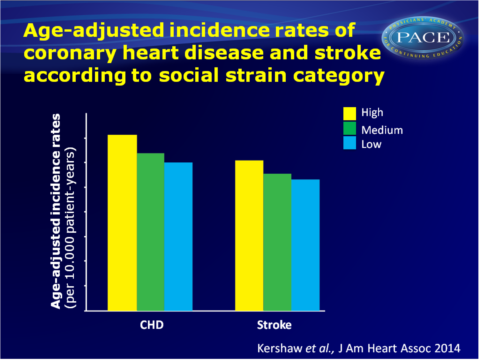Stressful life events and social strain associated with higher incident CHD and stroke
The Women’s Health Initiative observational study showed that these associations were explained by mediating behavioural and biological factors. Insights can help target stress management strategies.
Associations of Stressful Life Events and Social Strain With Incident Cardiovascular Disease in the Women's Health InitiativeLiterature - Kershaw KN et al., J Am Heart Assoc. 2014 - J Am Heart Assoc. 2014 Jun 27;3(3)
Kershaw KN, Brenes GA, Charles LE, et al.
J Am Heart Assoc. 2014 Jun 27;3(3)
Background
Epidemiological studies have yielded mixed results on the link between chronic psychosocial stress and cardiovascular disease (CVD) risk. Evidence suggests that stress is a significant predictor of stroke [1-3] , possibly only ischaemic, but not haemorrhagic, stroke [3]. Findings on the effect of stress on coronary heart disease (CHD) are less consistent. Differences between used definitions or use of different measures for stress may explain this, and it has been suggested that people reporting higher stress may also report more symptoms, thus introducing a bias.In this study, data was used from the Women’s Health Initiative (WHI) observational study, to study associations of baseline stressful life events (SLE) and social strain with incident CHD and stroke over 16 years of follow-up, independent of sociodemographic characteristics. This is a multiethnic cohort of postmenopausal women. Via a questionnaire, women were asked about the occurrence of 11 life events in the past year and to which extent the event had upset them, on a scale from 1 (did not upset me) to 3 (upset me very much), amounting to an SLE score between 0 and 33 (divided into approximate quartiles: low:0, medium-low: 1-2, medium-high: 3-4 and high: >5 based on the responses). Social strain was evaluated with 4 items derived from a previously validated measure of negative aspects of social relationships [4]. A total social strain score could range from 4 to 20, which was divided into approximate tertiles (low: 4, medium: 5-6, high: >7).
Main results
- Age-adjusted incidence rates (per 10.000 person-years) were highest for women in the highest SLE category (34.7, 95%CI: 32.3-37.4) and lowest among those in the lowest category (28.6, 95%CI: 26.3-31.0). Incident stroke rates varied from 28.7 (95%CI: 26.5-31.2) in the highest category, to 24.0 (95%CI: 21.9-26.3) in the lowest. Similar ranges of incidence rates were seen across social strain categories.
- In analyses adjusting for age, race/ethnicity, education, income, marital status and depressive symptoms, higher SLE and social strain scores were significantly associated with higher incidence CHD (P(trend)=0.01 for each). Women in the high (HR: 1.12, 95%CI: 1.01-1.25) and medium-high (HR: 1.11, 95%CI: 0.99-1.23) had higher adjusted hazard of incident CHD as compared with women in the low SLE category. Similar findings were seen for social stress categories.
- The relationships between each of the stressors and incident CHD were independent of the other stressor. The associations were attenuated with further adjustment for alcohol use, cigarette smoking, hypertension, high cholesterol, diabetes, abdominal obesity, physical activity and diet, and no statistically significant trends were seen.
- Women in the higher SLE category had a higher hazard of incident stroke (HRs ranging from 1.12 to 1.14, P(trend)=0.04) as compared to women in the low-strain category, just like women in the highest social strain category (HR: 1.10, 95%CI: 1.00-1.21). The medium-strain categories had no higher incident stroke rate than those in the low-strain category.
- Waist circumference and diabetes were the strongest, independent, mediators of the associations between stress and CHD.
- High vs. low SLE was similarly associated with a higher hazard of haemorrhagic and ischaemic stroke, while higher social strain was only associated with higher incident ischaemic stroke.
Download Kershaw JAHA 2014 PACE.pptx


Conclusion
This study shows that both stressful life events and social strain in a one year period are associated with higher incident CHD and stroke, independent of sociodemographic characteristics and depressive symptoms. The associations were explained by hypothesised mediating behavioural and biological factors, with the strongest effect for waist circumference and diabetes . These findings may help to develop more targeted interventions for stress management and lower CVD risk in women.Find this article on Pubmed
References
1. Jood K, Redfors P, Rosengren A, et al. Self-perceived psychological stress and ischemic stroke: a case-control study. BMC Med. 2009;7:53.
2. Kornerup H, Osler M, Boysen G, et al. Major life events increase the risk of stroke but not of myocardial infarction: results from the Copenhagen City Heart Study. Eur J Cardiovasc Prev Rehabil.
2010;17:113–118.
3. O’Donnell MJ, Xavier D, Liu L, et al; Investigators I. Risk factors for ischaemic and intracerebral haemorrhagic stroke in 22 countries (the INTERSTROKE study): a case–control study. Lancet. 2010;376:112–123
4. Antonucci TA, Kahn RC, Akiyama H. Psychosocial factors and the response to cancer symptoms. In: Yanick R, Yaes JW, eds. Cancer in the Elderly: Approaches to Early Detection and Treatment. New York, NY: Springer Publishing Company; 1989:40–52.
